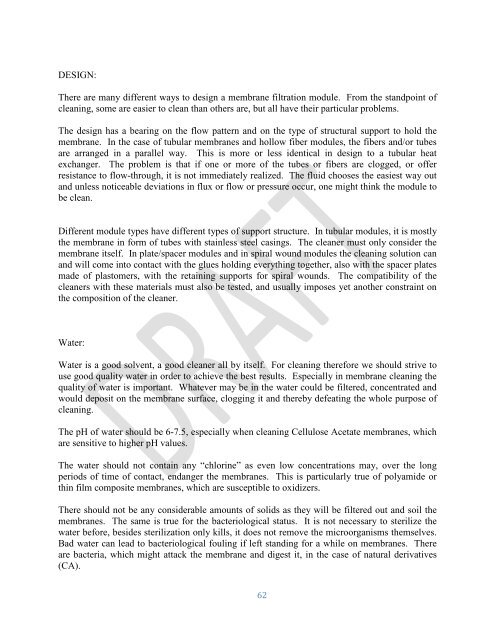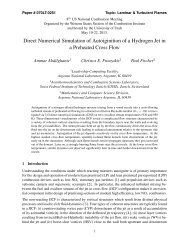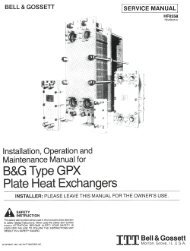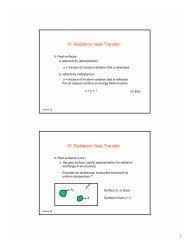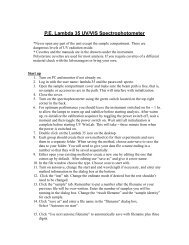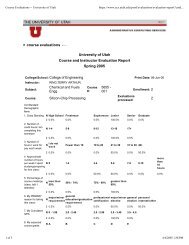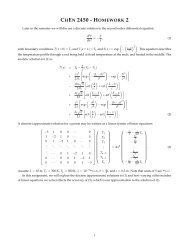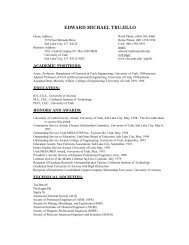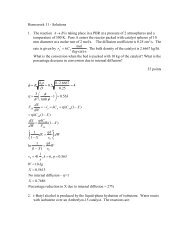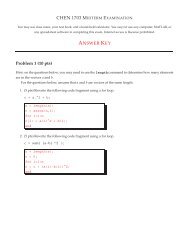Standard Operating Procedure - Ultrafiltration - Department of ...
Standard Operating Procedure - Ultrafiltration - Department of ...
Standard Operating Procedure - Ultrafiltration - Department of ...
- No tags were found...
Create successful ePaper yourself
Turn your PDF publications into a flip-book with our unique Google optimized e-Paper software.
DESIGN:There are many different ways to design a membrane filtration module. From the standpoint <strong>of</strong>cleaning, some are easier to clean than others are, but all have their particular problems.The design has a bearing on the flow pattern and on the type <strong>of</strong> structural support to hold themembrane. In the case <strong>of</strong> tubular membranes and hollow fiber modules, the fibers and/or tubesare arranged in a parallel way. This is more or less identical in design to a tubular heatexchanger. The problem is that if one or more <strong>of</strong> the tubes or fibers are clogged, or <strong>of</strong>ferresistance to flow-through, it is not immediately realized. The fluid chooses the easiest way outand unless noticeable deviations in flux or flow or pressure occur, one might think the module tobe clean.Different module types have different types <strong>of</strong> support structure. In tubular modules, it is mostlythe membrane in form <strong>of</strong> tubes with stainless steel casings. The cleaner must only consider themembrane itself. In plate/spacer modules and in spiral wound modules the cleaning solution canand will come into contact with the glues holding everything together, also with the spacer platesmade <strong>of</strong> plastomers, with the retaining supports for spiral wounds. The compatibility <strong>of</strong> thecleaners with these materials must also be tested, and usually imposes yet another constraint onthe composition <strong>of</strong> the cleaner.Water:Water is a good solvent, a good cleaner all by itself. For cleaning therefore we should strive touse good quality water in order to achieve the best results. Especially in membrane cleaning thequality <strong>of</strong> water is important. Whatever may be in the water could be filtered, concentrated andwould deposit on the membrane surface, clogging it and thereby defeating the whole purpose <strong>of</strong>cleaning.The pH <strong>of</strong> water should be 6-7.5, especially when cleaning Cellulose Acetate membranes, whichare sensitive to higher pH values.The water should not contain any “chlorine” as even low concentrations may, over the longperiods <strong>of</strong> time <strong>of</strong> contact, endanger the membranes. This is particularly true <strong>of</strong> polyamide orthin film composite membranes, which are susceptible to oxidizers.There should not be any considerable amounts <strong>of</strong> solids as they will be filtered out and soil themembranes. The same is true for the bacteriological status. It is not necessary to sterilize thewater before, besides sterilization only kills, it does not remove the microorganisms themselves.Bad water can lead to bacteriological fouling if left standing for a while on membranes. Thereare bacteria, which might attack the membrane and digest it, in the case <strong>of</strong> natural derivatives(CA).62


